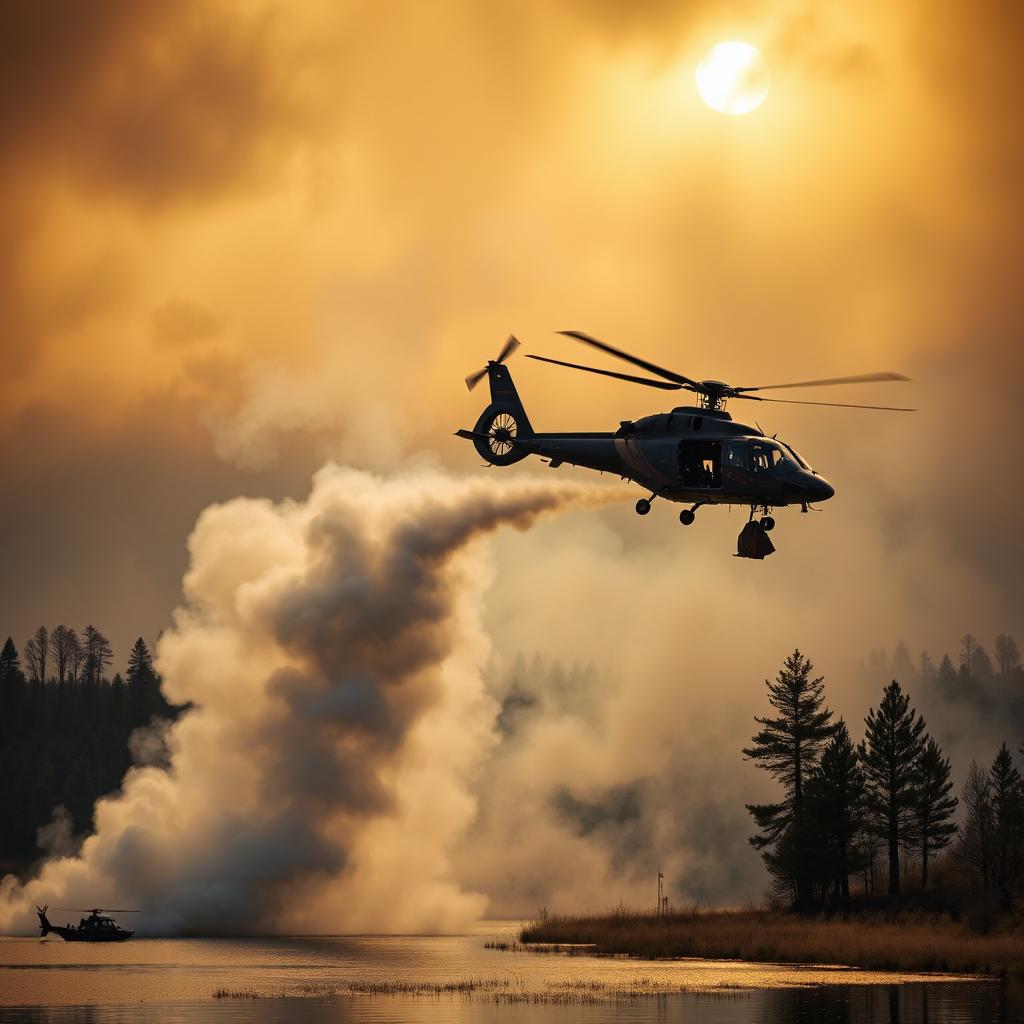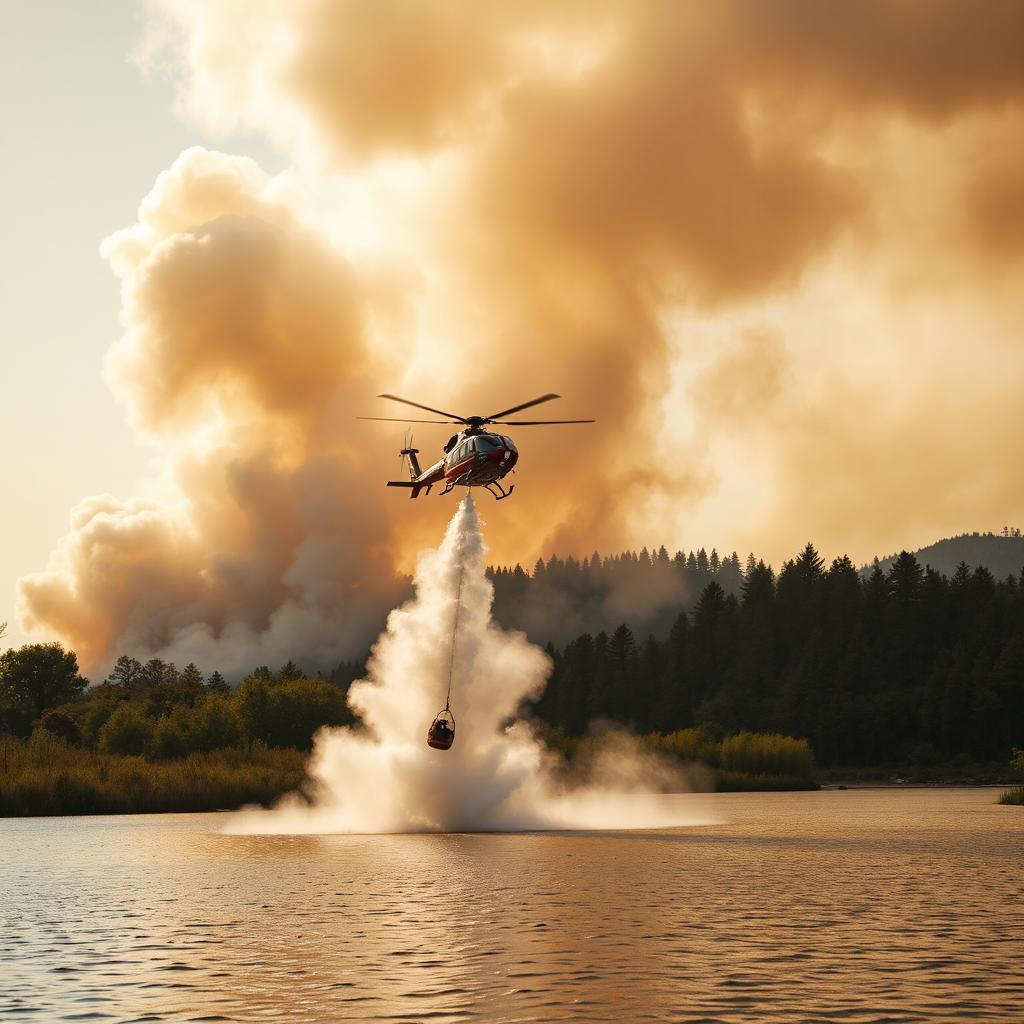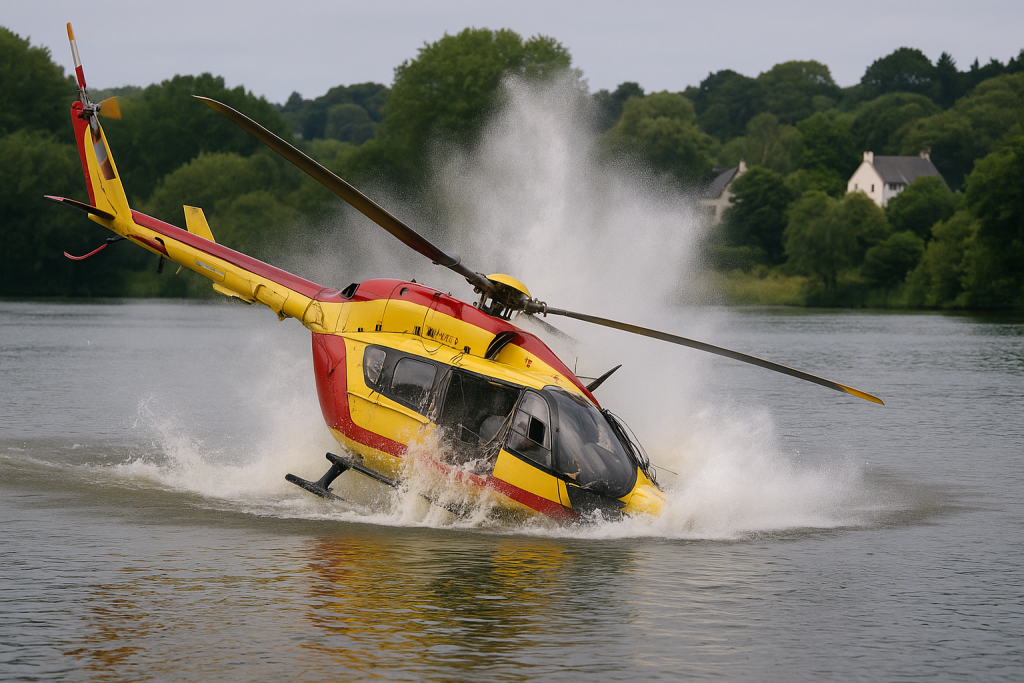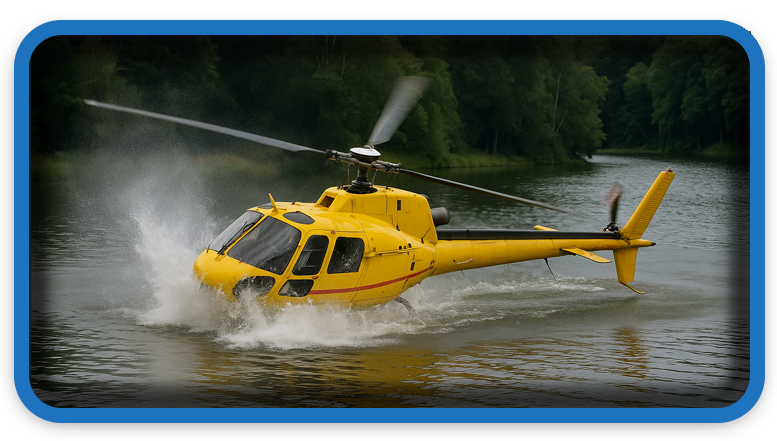⏲️ Estimated reading time: 10 min
Helicopter Crash in France During Water Scoop at Rosporden Lake. During France’s fight against a fierce forest fire, a water-bombing helicopter crashed while scooping from a lake. After 27 drops, it descended too fast, dipped its tail, and went down yet both crew survived. Inside: causes, risks, and lessons for readers.
Helicopter Crash in France: A Close Call During Forest Fire Battle
On a tense summer evening in Brittany, France, a firefighting helicopter engaged in a critical mission to contain a fast-moving blaze ended in a dramatic water-scoop crash. While refilling its “Bambi Bucket” at Rosporden Lake (Finistère), the aircraft’s tail touched the water and the helicopter lost control, spinning and breaking apart on impact. In a remarkable stroke of fortune and proof of rigorous training both people aboard escaped and reached the shore unharmed. Local authorities confirmed an investigation is underway, and the aircraft has since been replaced to sustain operations. (TF1 INFO, BFMTV)
Beyond the viral video shock, this incident illuminates the razor-thin margins aerial crews navigate on every drop. In this post, we unpack what happened, how aerial water-scooping actually works, why it’s so risky, and how the broader wildfire picture in France and Europe is shifting under climate pressure. We also highlight the human, technical, and organizational elements that keep these missions possible and as safe as they can be. (TF1 INFO)
The Incident: What We Know So Far
Time, place, and outcome
- When & where: Sunday, 24 August 2025, at the Rosporden water body in Finistère (Brittany).
- What happened: During a low-altitude water scoop, the helicopter’s tail contacted the lake; the aircraft spun and crashed into the water.
- Casualties: None. Both occupants the pilot and an onboard firefighter self-rescued and reached the shore safely.
- Next steps: An official inquiry was opened; a replacement helicopter was mobilized to maintain operations. (TF1 INFO, BFMTV)
The 27-drop day
Earlier that same day, an ongoing brush fire at Beuzec-Cap-Sizun saw the helicopter perform 27 water drops a demanding tempo that conveys how intense, repetitive, and fatiguing these sorties can become. (Le Télégramme)
Official communications and follow-up
Regional and national outlets, along with the Préfecture du Finistère and SDIS 29 (the local fire and rescue service), reported the crew’s safe outcome, the opening of an investigation, and the plan to extract the wreckage. Officials also noted that the helicopter known locally as “Morane 29” has been deployed each summer since 2023 to bolster wildfire response. (TF1 INFO, X (formerly Twitter))
Key point: The cause of the crash has not been formally determined at the time of writing; any contributing factors (pilot workload, wind shear, surface effects, etc.) remain speculative pending the investigation. (BFMTV)
Aerial Firefighting 101: Why Water-Scooping Is So Demanding
The mechanics of a water scoop
Helicopters typically carry a flexible Bambi Bucket slung below the fuselage. To refill, the pilot hovers inches above the surface, stabilizes the aircraft against wind and rotor downwash, submerges the bucket, fills to target load, then climbs out while compensating for the sudden weight and pendulum effect. Precision matters: altitude, airspeed, attitude, and load must remain within tight tolerances to avoid tail or rotor strikes and loss of control.
Environmental chaos is the norm
- Wind gradients near water and terrain can change abruptly.
- Smoke and glare degrade visibility and depth perception.
- Thermals and gusts around the fireline perturb the approach path.
- Surface effect over water affects hover handling; a tail-low attitude increases strike risk.
Human and machine at the limit
Each drop is a high-workload micro-mission. Multiply that by 20–30 cycles in a day and fatigue becomes a safety factor slowing reaction times and increasing the risk of small misjudgments compounding. Meanwhile, helicopters are complex systems; even minor mechanical issues can become serious when operating low and slow over water and rugged terrain.

Risks Unique to Low-Altitude Aerial Firefighting
- Obstacle collision: Trees, wires, towers, and ridge lines are unforgiving at rotor height.
- Load dynamics: A slung bucket can swing; rapid loading changes aircraft stability.
- Brownout/whiteout equivalents: Smoke and spray can momentarily blind the pilot.
- Crew fatigue: Repetition under stress degrades performance; robust rest cycles matter.
- Mechanical stress: Heat, particulate ingestion, and repeated heavy lift cycles wear components.
In the Rosporden event, available videos and eyewitness accounts show a tail contact during the scoop, followed by a rapid loss of control and water impact. Again, exact causal chains are a matter for investigators; the public evidence only shows the sequence, not the root cause. (TF1 INFO, BFMTV)
The Day’s Operational Context
The same aircraft worked a Beuzec-Cap-Sizun fire earlier, with 27 drops recorded as part of a multi-hour effort illustrating how aerial assets get cycled intensively as conditions demand. That intensity underscores the need for crew resource management (CRM), fatigue monitoring, and relief rotations for pilots and ground crews guiding bucket operations from the shoreline and staging areas. (Le Télégramme)
Authorities emphasized that continuity of operations was preserved: another aircraft replaced Morane 29 quickly, and an environmental mitigation cell was deployed to address any potential pollution from the wreckage. (Le Télégramme, TF1 INFO)
France & Europe’s Wildfire Trend Line
2022: a watershed year
Europe’s 2022 wildfire season ranks among the worst on record since EFFIS monitoring began, with ~900,000 hectares burned in the EU and exceptionally severe seasons in Spain, France, Portugal, Slovenia, and Czechia. France itself endured an unprecedented summer of wildfires that year, with ~72,000 hectares burned about seven times the recent annual average. (EU Science Hub, Copernicus Climate Change Service, Le Monde.fr)
2023 and beyond
The 2023 season was again among the worst this century in Europe, per the European Commission’s Joint Research Centre, reinforcing that these severe years are not isolated anomalies. Preliminary data for later seasons point to continued volatility. (Reuters)
What’s driving it?
- Hotter, drier summers and longer fire seasons, consistent with climate-change projections.
- Fuel buildup in forests and shrublands without regular low-intensity burns.
- Expanding wildland-urban interface, raising stakes for suppression near communities.
These macro trends set the backdrop for incidents like Rosporden: more ignitions, more simultaneous fires, longer deployments, and more strain on aerial and ground assets.
The Human Element: Training, Discipline, Courage
The Rosporden crew’s self-rescue highlights the value of drills, egress training, and situational awareness under extreme pressure. Standard operating procedures emphasize rehearse-to-automaticity: jettisoning loads, shutting down fuel/elec if feasible, and rapid egress especially important in water impacts where seconds count.
Psychological load matters, too. Firefighting personnel face cumulative stress from long campaigns, dangerous sorties, and exposure to destruction. Peer support, access to mental-health resources, and leadership that normalizes help-seeking are critical to retention and safety culture.
Lessons Learned: Improving Safety and Effectiveness
1) Enhance training refreshers for water-scoop profiles
Regular simulator-aided refreshers and scenario-based training for tail-strike avoidance, gust response, and bucket-pendulum control help maintain margins in the trickiest profiles.
2) Tighten fatigue management
Track pilot duty cycles in high-tempo operations; cap repetitive scoops in short windows, add micro-breaks, and rotate crews. CRM should include explicit challenge-and-response checks before each scoop approach.
3) Upgrade situational tools
- Laser altimeters and radar height callouts for low-level awareness.
- Augmented stabilized camera feeds to see through spray and smoke.
- UAS (drones) to scout water-scoop lanes for wires, boaters, and debris.
4) Improve load & approach management
Dynamic load-sensing on the sling system and approach gate criteria (abort if outside parameters) can reduce marginal scoops. Shore-based spotters on comms can call go-around early if approach geometry looks off.
5) Environmental safeguards
Rapid pollution-control deployment at crash sites (booms, absorbent pads) limits ecological impact exactly what local teams initiated at Rosporden. (Le Télégramme)

The Broader System: France’s Summer Air Asset “Morane 29”
Since 2023, “Morane 29” has been deployed each summer to reinforce Finistère’s wildfire response an investment driven by the Monts d’Arrée fires in 2022 and the need for faster first strikes on new ignitions. Authorities say the helicopter has repeatedly proved its value in containing early-stage fires. (TF1 INFO, Tébéo & Tébésud)
Budget-sharing between the State and the Department helps fund these seasonal capabilities, and public-facing communications from SDIS 29 and the Préfecture have emphasized both the aircraft’s utility and the system’s resilience visible in how quickly a replacement aircraft took over after the crash. (X (formerly Twitter), TF1 INFO)
Practical Guidance for Communities Near Fire Zones
- Stay informed: Follow local prefecture and SDIS channels for evacuation guidance.
- Prepare properties: Maintain defensible space; clear brush and gutters.
- Mind water bodies: When helicopters are scooping, keep small craft well clear of lanes.
- Report early: Call 112 for smoke sightings; early intel saves minutes and hectares.
What This Incident Tells Us
- Margins are narrow: Tail clearance over water can be measured in feet; a small deviation can cascade.
- Training pays off: The crew’s calm egress prevented tragedy. (TF1 INFO)
- Systems matter: Rapid replacement of air assets and pollution response kept the wider operation on track. (Le Télégramme, TF1 INFO)
- The trend is bigger than one crash: More severe fire seasons raise operational tempo and risk across Europe. (Reuters, EU Science Hub)
Final Takeaway
The helicopter crash at Rosporden is a vivid reminder that aerial firefighting is one of the most unforgiving missions in public safety. Even with experienced crews, proven aircraft, and disciplined procedures, low-level water operations compress risk into seconds. The good news is that France’s integrated response trained crews, resilient logistics, and clear public communications worked as designed: the crew survived, operations continued, and the community stayed protected.
Looking forward, the combination of training refreshers, fatigue management, low-level tech aids, and drone-enabled reconnaissance can widen safety margins further. Yet the most important lever sits upstream: reducing the frequency and intensity of fires via prevention, land stewardship, and climate adaptation. Each drop counts, but so does every hectare we keep from igniting in the first place. (TF1 INFO, BFMTV, Reuters)

🔔 For more tutorials like this, consider subscribing to our blog.
📩 Do you have questions or suggestions? Leave a comment or contact us!
🏷️ Tags: aerial firefighting, France wildfires, helicopter crash, Rosporden, Morane 29, Finistère, SDIS 29, Beuzec-Cap-Sizun, wildfire safety, EFFIS
📢 Hashtags: #AerialFirefighting, #FranceWildfires, #HelicopterCrash, #Rosporden, #Morane29, #SDIS29, #WildfireSeason, #FirefightingHeroes, #ClimateChange, #Safety
Sources & further reading used in this article:
European wildfire context (2022–2023) from the European Commission’s JRC/EFFIS and Reuters. (EU Science Hub, Copernicus Climate Change Service, Reuters)
TF1 Info report confirming the crash at Rosporden and crew safety, plus replacement asset details. (TF1 INFO)
BFMTV recap noting the investigation and non-fatal outcome. (BFMTV)
Le Télégramme coverage documenting 27 water drops earlier that day at Beuzec-Cap-Sizun. (Le Télégramme)
- Local authorities’ statements on the incident
- European Forest Fire Information System (EFFIS)
- General knowledge on aerial firefighting and wildfire management
Only logged-in users can submit reports.
Discover more from HelpZone
Subscribe to get the latest posts sent to your email.

